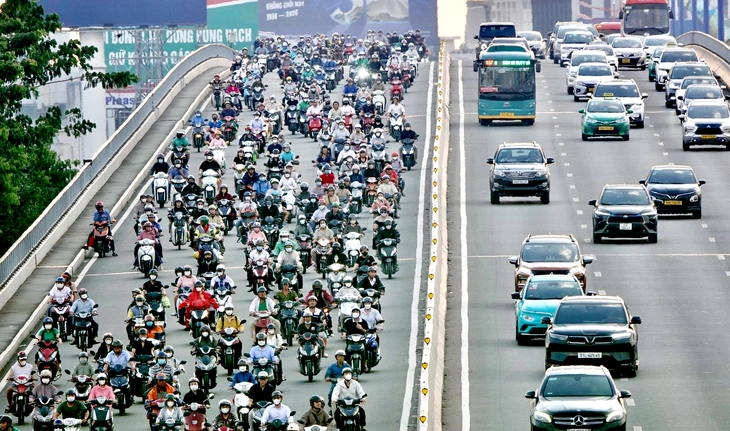The proposal to establish a Low Emission Zone (LEZ) to control vehicle emissions by the Ho Chi Minh City Department of Construction is certain to receive public approval, as everyone desires to live in a clean environment.
However, what concerns people is whether the zoning solution for the LEZ is feasible.
According to the proposal, Phase 1, starting in 2026, will establish a low emission zone in central Ho Chi Minh City, bounded by 15 bridges and 20 main roads.
It’s important to remember that Ho Chi Minh City is an open city, with millions of trips entering and leaving the central area daily. So, how will non-compliant cars and motorcycles be controlled? By setting up control stations with barriers, establishing teams to measure emissions, creating impound lots for violating vehicles…?
Even the ambition to install a camera system to identify non-compliant vehicles is not feasible, as cameras only record images and cannot indicate the harmful emission levels produced by gasoline and diesel vehicles. These indicators must be measured with specialized equipment.
Furthermore, if the plan’s scope is only expanded to Beltway 1 by 2032, it is too slow. When will it ever cover the entire 6,700 km² area, and it falls far short of the net-zero emissions target by 2050.
Therefore, should Ho Chi Minh City accelerate the timeline and scale using a different approach? Singapore controls vehicle emission pollution primarily through Euro emission standards.
For gasoline or diesel cars, compliance with the Euro VI standard is mandatory, while for gasoline motorcycles, it’s Euro IV.
This means what type of vehicle you buy and what fuel you use is your choice, but if your vehicle’s emissions exceed the Euro VI standard for cars or the Euro IV standard for motorcycles when driven on the road, you will face heavy fines and your vehicle will be banned from road use.
Of course, the technical standards of Euro IV or Euro II are still quite unfamiliar to the public. Therefore, the city administration should adopt methods used in cities in China.
This involves installing Euro II standard measurement machines at gas stations to determine the levels of CO (Carbon Monoxide), HC (Hydrocarbons), NOx (Nitrogen Oxides) – harmful substances produced by gasoline and diesel vehicles from burning fossil fuels – and PM (particulate matter).
Residents simply need to stop by a station and pay a measurement fee (equivalent to the price of one liter of gasoline) to find out their vehicle’s emission level. This is entirely feasible because the former Ho Chi Minh City area has over 600 gas stations, with technical support from universities and quality measurement centers.
This awareness and preparation period (financial, psychological) could last 1-2 years, after which residents would have three months to find a reasonable solution. If their vehicle exceeds the standard, they must repair or upgrade it; if it’s too old, they should scrap it and potentially take out loans to buy a new electric vehicle.
Then, at a certain point in 2028 or 2030, sanctions would be uniformly applied across the entire city.
Ho Chi Minh City is fully capable of achieving this, as it has successfully implemented alcohol control according to Decree 100 and previously mandated helmet use for motorcycle riders in 2007.
With the right goals, reasonable solutions, a suitable roadmap, and consensus between the people and the government, success is certain. Think big and act big for a mega-metropolis.
At the 2021 United Nations Climate Change Conference (COP26), the Vietnamese Government committed to achieving net-zero emissions by 2050. So, what must be done to achieve this commitment in the Southeast region?






